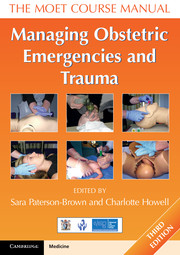Book contents
- Frontmatter
- Dedication
- Contents
- Working Group
- About the authors
- Acknowledgements
- Abbreviations
- Section 1 Introduction
- Section 2 Recognition
- Section 3 Resuscitation
- Section 4 Trauma
- Section 5 Other medical and surgical emergencies
- Section 6 Obstetric emergencies
- 24 Pre-eclampsia and eclampsia
- 25 Major obstetric haemorrhage
- 26 Caesarean section
- 27 Placenta accreta and retained placenta
- 28 Uterine inversion
- 29 Ruptured uterus
- 30 Ventouse and forceps delivery
- 31 Shoulder dystocia
- 32 Umbilical cord prolapse
- 33 Face presentation
- 34 Breech delivery and external cephalic version
- 35 Twin pregnancy
- 36 Complex perineal and anal sphincter trauma
- 37 Symphysiotomy and destructive procedures
- 38 Anaesthetic complications in obstetrics
- Section 7 Triage and transfer
- Section 8 Human issues
- Index
31 - Shoulder dystocia
- Frontmatter
- Dedication
- Contents
- Working Group
- About the authors
- Acknowledgements
- Abbreviations
- Section 1 Introduction
- Section 2 Recognition
- Section 3 Resuscitation
- Section 4 Trauma
- Section 5 Other medical and surgical emergencies
- Section 6 Obstetric emergencies
- 24 Pre-eclampsia and eclampsia
- 25 Major obstetric haemorrhage
- 26 Caesarean section
- 27 Placenta accreta and retained placenta
- 28 Uterine inversion
- 29 Ruptured uterus
- 30 Ventouse and forceps delivery
- 31 Shoulder dystocia
- 32 Umbilical cord prolapse
- 33 Face presentation
- 34 Breech delivery and external cephalic version
- 35 Twin pregnancy
- 36 Complex perineal and anal sphincter trauma
- 37 Symphysiotomy and destructive procedures
- 38 Anaesthetic complications in obstetrics
- Section 7 Triage and transfer
- Section 8 Human issues
- Index
Summary
Objectives
On successfully completing this topic, you will be able to:
understand the aetiology and complications of shoulder dystocia
understand the risk factors for shoulder dystocia
be aware of strategies that can be tried to prevent shoulder dystocia
be confident in understanding the variety of obstetric manoeuvres used to overcome shoulder dystocia
appreciate the benefits of formal skills/drills training on maternal and fetal outcomes in cases of shoulder dystocia.
Introduction
Shoulder dystocia remains one of the most dreaded obstetric complications and one that is often unanticipated. It is associated with significant perinatal mortality and morbidity, maternal morbidity and is a costly source of litigation. In this chapter, a number of matters will be addressed.
Definition and incidence
Shoulder dystocia describes difficulties encountered with delivering the shoulders after the fetal head is born. Discrepancies in the definition have resulted in differences in the reported incidence of this obstetric emergency from 0.15% to 2% of all vaginal deliveries. MOET considers shoulder dystocia to be a condition requiring special manoeuvres to deliver the shoulders that have been arrested due to impaction of the anterior shoulder above the symphysis pubis.
Clinical risks and outcomes
Fetal mortality and morbidity
Shoulder dystocia is still a significant cause of term fetal mortality. In the CESDI annual report for 1993, shoulder dystocia was responsible for 8% of all intrapartum fetal deaths. A later, focused report (1998) critically reviewed 56 cases of death associated with shoulder dystocia: 47% had died despite delivery within 5 minutes and, in 37 (66%) cases, the level of substandard care offered by professionals was graded at ‘level 3’ (i.e. a different management would have likely resulted in an improved outcome). The babies were delivered by both midwives and medical staff, emphasising the need for all professionals involved in delivery to be aware of appropriate drills.
- Type
- Chapter
- Information
- Managing Obstetric Emergencies and TraumaThe MOET Course Manual, pp. 369 - 382Publisher: Cambridge University PressPrint publication year: 2014



